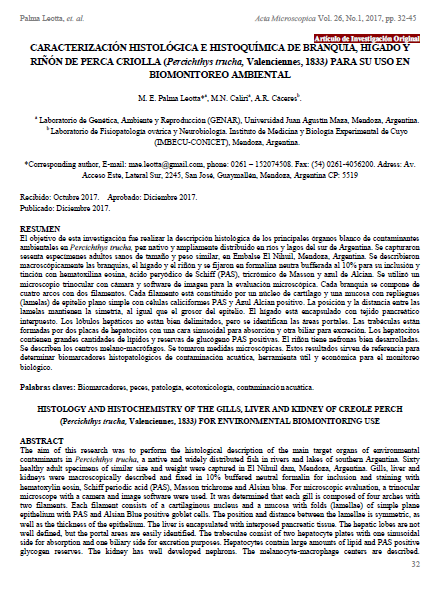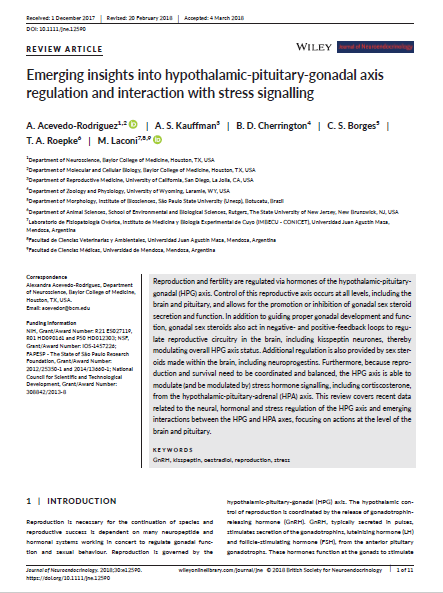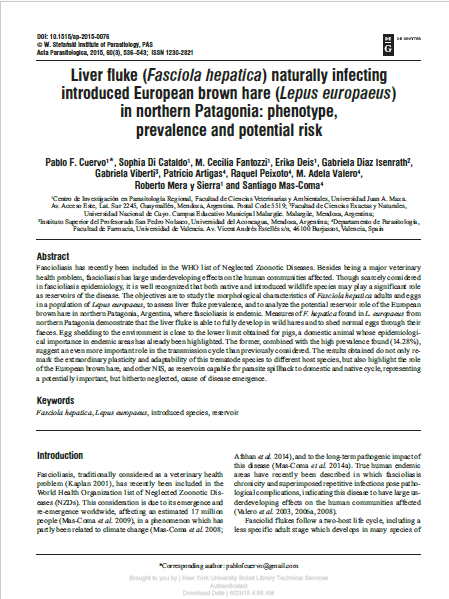Browsing Ciencias veterinarias by Title
Now showing items 1-20 of 25
-
Agroquímicos: las consecuencias del uso sin control
(2018-04-09)Se aborda el tema de los posibles problemas de salud debido al uso de estos productos (plaguicidas, herbicidas, insecticidas), que en algunos casos son tóxicos. Muchos de ellos son utilizados en la agricultura o ganadería y otros, incluso, dentro del ámbito doméstico. -
Analysis of the rumen bacterial diversity of goats during shift from forage to concentrate diet.
(Comité editor Journal Anaerobe, 2016-07-12)High-grain feeding used in the animal production is known to affect the host rumen bacterial community, but our understanding of consequent changes in goats is limited. This study was therefore aimed to evaluate bacterial population dynamics during 20 days adaptation of 4 ruminally cannulated goats to the high-grain diet (grain: hay e ratio of 40:60). The dietary transition of goats from the forage to the high-grain-diet resulted in the significant decrease of rumen fluid pH, which was however still higher than value established for acute or subacute ruminal acidosis was not diagnosed in studied ... -
Biomonitoring of the hematological, biochemical and genotoxic effects of the mixture cypermethrin plus chlorpyrifos applications in bovines
(Science of the Total Environment Editorial, 2020-03-19)External antiparasitic agents applied in bovine production represent a risk to consumers of meat products, espe- cially if the conditions of their use are not strictly respected. The post-mortem control of residues in meat is an activity that must be updated and reinforced by the biomonitoring of live animals and the use of analytical tools to help identifying signs of early warning risks. The objective of the present study was to carry out a pre- slaughter biomonitoring approach in Aberdeen Angus cattle and crosses (n = 12) with the application of a com- mercial formulation of cypermethrin ... -
Caracterización histológica e histoquímica de branquia, hígado y riñón de perca criolla ( Percichthys trucha, Valenciennes, 1833 ) para su uso en biomonitoreo ambiental
(Comité editorial Acta microscópica, 2017-12)El objetivo de esta investigación fue realizar la descripción histológica de los principales órganos blanco de contaminantes ambientales en Percichthys trucha, pez nativo y ampliamente distribuido en ríos y lagos del sur de Argentina. Se capturaron sesenta especímenes adultos sanos de tamaño y peso similar, en Embalse El Nihuil, Mendoza, Argentina. Se describieron macroscópicamente las branquias, el hígado y el riñón y se fijaron en formalina neutra bufferada al 10% para su inclusión y tinción con hematoxilina eosina, ácido peryódico de Schiff (PAS), tricrómico de Masson y azul de Alcian. Se ... -
Diet mixing and condensed tannins help explain foraging preferences by Creole goats facing the physical and chemical diversity of native woody plants in the central Monte desert (Argentina).
(Comité editorial Animal Feed Science and Technology, 2016-02-26)The aim of this study was to understand the benefit of diet mixing for Creole goats grazingnative forage species in the central Monte desert of Argentina and the drivers of preferencein the mixed diet. To achieve this goal, cafeteria-style experiments were conducted withthirty female Creole goats (2 years old; 44 ± 1.4 kg) and forage species that are typicallyingested by goats in this region: Two tanniniferous (Tricomaria usillo, Mimosa ephedroides)and three non-tanniniferous shrubs (Prosopis flexuosa, Capparis atamisquea, Atriplex lampa).In Experiment 1, goats were assigned to three groups (n ... -
Effect of the length of the suckling period and dietary energy intake in lactation on the duration of postpartum anestrus in Creole goats.
(Comité editorial Small Ruminant Research, 2016-04-16)The objective of this study was to determine the effect of the length of the suckling period and the dietary energy level on the duration of postpartum anestrus in Creole goats. Twenty-eight multiparous pregnant goats (bodyweight BW 39.9 ± 6.4 kg; mean ± SEM) each bearing a single fetus were used in a 2 suckling period (30 vs. 60 d) × 2 levels of energy intake (low (L) vs. high (H)) factorial design. Kids were separated from their dams 3 d after birth and then suckled twice per day until weaned at 30 or 60 d postpartum. Dams weaned at 30 d postpartum were hand milked for the next 30 d. Goats ... -
Emerging insights into hypothalamic-pituitary- gonadal axis regulation and interaction with stress signalling.
(Comité editorial Journal of Neuroendocrinology, 2018-10-30)Reproduction and fertility are regulated via hormones of the hypothalamic-pituitary-gonadal (HPG) axis. Control of this reproductive axis occurs at all levels, including the brain and pituitary, and allows for the promotion or inhibition of gonadal sex steroid secretion and function. In addition to guiding proper gonadal development and function, gonadal sex steroids also act in negative-and positive-feedback loops to regulate reproductive circuitry in the brain, including kisspeptin neurones, thereby modulating overall HPG axis status. Additional regulation is also provided by sex steroids made ... -
Enfermedades que pueden transmitirnos nuestras mascotas
(2019-08-13)Reportaje de Canal 9 Televida, Mendoza al Dr. Roberto Mera y Sierra. En estos momentos hay una emergencia mundial por la mordedura de garrapatas en humanos. En Mendoza y en las ciudades también se ha visto un crecimiento de la hidatidosis, una enfermedad provocada por la materia fecal del animal, entre otras. -
Epidemiological link between canine monocytic ehrlichiosis caused by Ehrlichia canis and the presence of Rhipicephalus sanguineus sensu stricto in Argentina
(Parasitology Research Editorial, 2021-01-08)In this work, we analyze data that support an epidemiological link between cases of canine monocytic ehrlichiosis (CME) by Ehrlichia canis and the presence of Rhipicephalus sanguineus sensu stricto as vector in an endemic area for this tick in Argentina. In a blood sample of a 1-year-old toy poodle with CME compatible clinical signs, which showed CME typical morulae in monocytes in Giemsa-stained blood smear, DNA of E. canis was detected by PCR. Further, DNA of E. canis was also detected in a female of R. sanguineus s.s. collected on the infected dog. Rhipicephalus sanguineus s.s. is the only ... -
Erythrocyte micronucleus cytome assay of 17 wild bird species from the central Monte desert, Argentina.
(Editorial Environmental Science and Pollution Research, 2016-09-29)Birds have the potential to be considered valuable bioindicators of the quality of ecosystems and the environmental impact of pollutants. The aims of this study were to determine the micronuclei frequency and other nuclear abnormalities in erythrocytes by analyzing a wild bird community from central Monte desert (Argentina) and to clarify if there were any differences among certain species. Frequencies of nuclear abnormalities were determined in 73 wild birds belonging to 17 species and two orders (Passeriformes and Columbiformes). A high proportion of individuals, 90.4 and 80.9 %, had erythrocytes ... -
Evaluation of the genotoxic potential of cypermethrin, chlorpyrifos and their subsequent mixture, on cultured bovine lymphocytes
(Comité editorial Chemosphere Journal, 2019-11-09)Cypermethrin (CYP) and chlorpyrifos (CPF) are insecticides/parasiticides used in the production of fruits, vegetables and beef cattle. These substances or their metabolites are frequently reported as residues in food, whose consumption in a diet implies a genotoxic risk. The potential for chronic toxicity of CYP and CPF is unclear, and only a few genotoxicological evaluations based on their mixture have been performed. The aim of this study was to evaluate the genotoxic potential of CYP, CPF and CYP þ CPF in five concentrations, from 5.9 to 175 mg/mL, on bovine lymphocytes. By means of the ... -
In vivo assessment of closantel ovicidal activity in Fasciola hepatica eggs.
(Editorial Experimental Parasitology, 2016)Anthelmintic resistance in livestock parasites is currently a worldwide problem. Fasciola hepatica is a cosmopolitan parasite which causes considerable loss in sheep and cattle production systems all over the world. Chemotherapy is currently the main tool available for its control. The intensive use of triclabendazole, the drug of choice for more than 20 years, has resulted in the development of resistant strains. The therapeutic options are adulticides such as closantel (salicylanilide anthelmintic that binds extensively to plasma albumin) to treat chronic fascioliasis in sheep, and cattle. In ... -
Liver fluke (Fasciola hepatica) naturally infecting introduced European brown hare (Lepus europaeus) in northern Patagonia: phenotype, prevalence and potential risk
(Comité editorial Acta Parasitologica, 2015-06-23)Fascioliasis has recently been included in the WHO list of Neglected Zoonotic Diseases. Besides being a major veterinary health problem, fascioliasis has large underdeveloping effects on the human communities affected. Though scarcely considered in fascioliasis epidemiology, it is well recognized that both native and introduced wildlife species may play a significant role as reservoirs of the disease. The objectives are to study the morphological characteristics of Fasciola hepatica adults and eggs in a population of Lepus europaeus, to assess liver fluke prevalence, and to analyze the potential ... -
Plasma Cholinesterase Activity in Wild Birds from Undisturbed Woodlands in the Central Monte Desert
(2019-04-30)Plasma cholinesterase activity is a biomarker sensitive to the effect of organophosphate and carbamate pesticides, and its enzymatic levels have been previously unknown for most of the wild birds analyzed in the present study. Our objectives were to establish plasma acetylcholinesterase levels in songbirds of 2 undisturbed sites in the central Monte Desert (Argentina). We also examined the influence on cholinesterase activity of age, sex, body condition, feeding and migratory habits, and species. One hundred and sixty‐five wild birds belonging to 26 species were studied. The values obtained for ... -
Potential risks of dietary exposure to chlorpyrifos and cypermethrin from their use in fruit/vegetable crops and beef cattle productions.
(Comité editorial Environ Monitoring and Assessment, 2018-04-18)The active ingredients (a.i.) used as pesticides vary across regions. Diet represents the main source of chronic exposure to these chemicals. The aim of this study was to look at the pesticides applied in fruit, vegetable, and beef cattle productions in Mendoza (Argentina), to identify those that were simultaneously used by the three production systems. Local individuals (n = 160), involved in these productions, were interviewed. Glyphosate was the a.i. most often used by fruit-vegetable producers, and ivermectin by beef cattle producers. Chlorpyrifos (CPF) and cypermethrin (CYP) were the only ... -
Pseudobutyrivibrio xylanivorans adhesion to epithelial cells
(Comité editorial Anaerobe Journal, 2019-01-05)The ruminal bacteria Pseudobutyrivibrio xylanivorans strain 2 (P. xylanivorans 2), that mediates the digestion of plant fiber, is considered an attractive candidate for probiotics. Adherence to the epithelium of the digestive tract of the host is one of the major requirements for probiotics. In this study, we assessed the adhesion of P. xylanivorans 2 to SW480 cells and characterized this process utilizing multiple microscopy approaches. Our results indicate that a multiplicity of infection of 200 CFU/cell allows the highest bacteria to cell binding ratio, with a lower percentage of ...





























